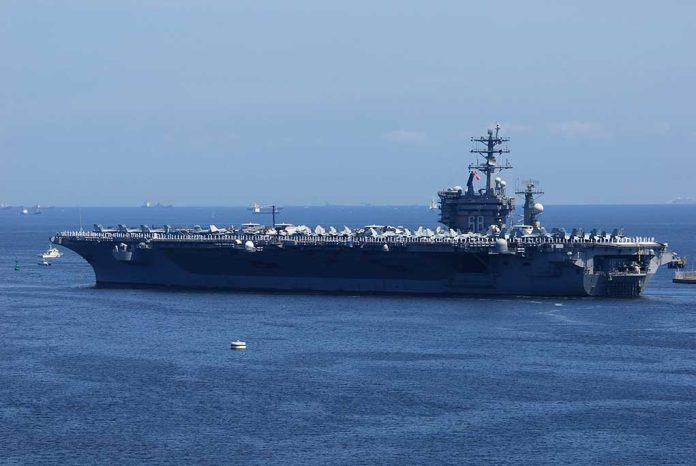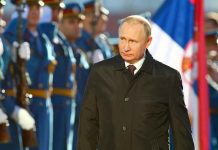
America sends a massive show of force to the South China Sea as the legendary USS Nimitz makes a final stand against China’s aggressive maritime expansion before its retirement next year.
Key Takeaways
- The USS Nimitz, on its final deployment before retirement in May 2025, has returned to the contested South China Sea to counter China’s territorial claims
- A powerful dual carrier presence has been established with the USS George Washington also deployed in the Western Pacific, significantly amplifying America’s military posture
- This strategic deployment serves both as a deterrent to Chinese aggression and as reassurance to regional allies like the Philippines amid escalating territorial tensions
- The USS Nimitz recently made strategic port calls in Malaysia and Guam, demonstrating America’s commitment to strengthening relationships with Indo-Pacific partners
- The deployment reinforces President Trump’s tough stance on protecting freedom of navigation and maintaining American dominance in critical maritime regions
Strategic Return of the USS Nimitz to Contested Waters
The USS Nimitz, one of America’s premier nuclear-powered aircraft carriers, has made a calculated return to the South China Sea, where China continues to make aggressive sovereignty claims against international law. This deployment marks a significant chapter in the vessel’s storied history as it conducts its final overseas mission before scheduled retirement in May 2025. The return of this formidable warship to contested waters sends an unmistakable message about America’s commitment to maintaining a free and open Indo-Pacific region. Ship-tracking data shows the Nimitz sailing toward Singapore, with its last recorded position northeast of Singapore in the South China Sea.
“Nimitz is conducting a port call in the U.S. [Seventh] Fleet area of operations on a scheduled deployment, demonstrating the U.S. Navy’s unwavering commitment to a free and open Indo-Pacific,” according to Newsweek.
The timing of the Nimitz’s return is particularly significant as it coincides with ongoing territorial disputes between China and neighboring countries, especially the Philippines. After operating in the South China Sea in early May, the carrier moved to the Strait of Malacca, which initially sparked speculation about a potential Middle East deployment. However, the decision to return the vessel to the South China Sea underscores the strategic importance President Trump places on countering China’s expanding maritime influence in the region.
Powerful Dual Carrier Presence Established
In a move that significantly amplifies America’s military posture in the Western Pacific, the USS George Washington has also been deployed to the region, creating a powerful dual carrier presence. This coordinated deployment represents one of the most formidable displays of American naval power in recent years. Additionally, the USS America, an amphibious assault ship capable of carrying fighter jets, has been dispatched to the Philippine Sea, further extending the reach and capabilities of American forces in the area.
“provides presence and combat-ready forces to the theater,” according to the U.S. Seventh Fleet,
While it remains uncertain whether the Nimitz, George Washington, and America will conduct joint operations in the Western Pacific in the near future, their simultaneous presence demonstrates America’s ability to project overwhelming force in multiple locations. The U.S. Seventh Fleet, based in Japan, plays a crucial role in executing this strategy, ensuring that American forces are positioned to respond rapidly to any potential aggression in the region. This massive show of force aligns perfectly with President Trump’s strong stance on maintaining American military superiority worldwide.
Strengthening Regional Alliances Through Strategic Port Calls
The USS Nimitz has been actively engaging with America’s regional partners through strategic port calls, recently hosting Malaysian naval officers during a visit to Malaysia. This marked the carrier’s second port call after an earlier stop in Guam. These diplomatic engagements serve a dual purpose: they strengthen military relationships with key allies while simultaneously demonstrating America’s long-term commitment to the region. By inviting foreign military officers aboard one of our most advanced warships, the United States provides tangible proof of its technological superiority and readiness to defend shared interests.
“Assets assigned to U.S. [Seventh] Fleet operate alongside allies and partners every day to deter aggression and maintain security in the Indo-Pacific,” according to the U.S. Seventh Fleet,
The significance of these port calls extends beyond military diplomacy. They represent America’s dedication to preserving freedom of navigation through some of the world’s most critical shipping lanes. With roughly one-third of global maritime trade passing through the South China Sea annually, maintaining open access to these waters is vital to the global economy. By asserting a strong presence in the region, President Trump’s administration is protecting not only American interests but also the economic stability of numerous nations that rely on these crucial shipping routes.





